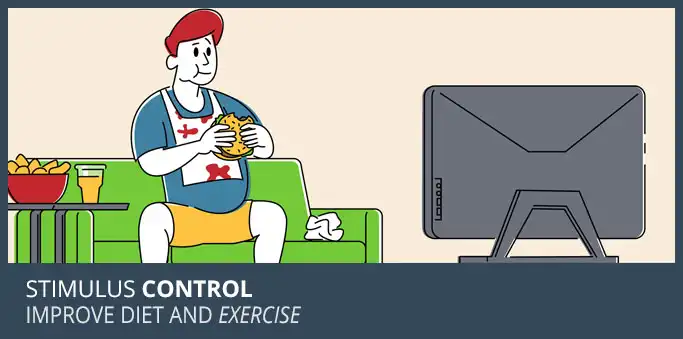The secret to a healthy lifestyle and improved weight control is a nutritious diet and balanced way of living. Keeping a food and weight journal, getting social support, and exercising frequently are some weight loss strategies.
According to the Centers for Disease Control and Prevention, around 93.3 million adultsTrusted Source in the United States had obesity in 2015–2016. This number is equivalent to 39.8 percent of the population.
In this article, we provide 10 tips for weight control.
1. Eat varied, colorful, nutritionally dense foods

The basis of a person’s diet should consist of nutritious meals and snacks. Making sure that each meal has 50% fruit and vegetables, 25% whole grains, and 25% protein is an easy way to create a meal plan. 25–30 grams of fiber should be consumed overall. Every day, Trusted Source (g).
Reduce your consumption of saturated fats, which are strongly associated with the risk of coronary heart disease, and get rid of trans fats from your diet.
As an alternative, people can eat unsaturated fats like polyunsaturated fatty acids (PUFA) and monounsaturated fatty acids (MUFA).
The following foods are healthful and often rich in nutrients:
- fresh fruits and vegetables
- fish
- legumes
- nuts
- seeds
- whole grains, such as brown rice and oatmeal
Foods to avoid eating include:
- foods with added oils, butter, and sugar
- fatty red or processed meats
- baked goods
- bagels
- white bread
- processed foods
2. Keep a food and weight diary

A key component of weight loss success is self-monitoring. To track every food item they eat each day, people can use a dedicated website, mobile app, or paper diary. Another way they can track their development is by keeping a weekly weight log.
A person is far more likely to maintain a weight loss program if they can recognize physical changes and track their progress in tiny increments.
People can also keep track of their body mass index (BMI) using a BMI calculator.
3. Engage in regular physical activity and exercise

Exercise on a regular basis is essential for mental and physical well-being. For weight loss to be successful, increasing physical activity frequency in a deliberate and disciplined manner is frequently essential.
It’s best to engage in one hour of moderate-intensity exercise per day, like brisk walking. The Mayo Clinic advises that if an hour a day is not feasible, one should try to get at least 150 minutes each week.
Individuals who do not typically engage in physical activity should gradually increase both the quantity and intensity of their exercise. The best way to guarantee that regular exercise becomes a part of their lifestyle is to take this approach.
People may benefit psychologically from tracking their physical activity in the same way that keeping a food journal can aid in weight loss. After logging food intake and exercise, a person can use one of the many free mobile apps available to track their calorie balance.
4. Eliminate liquid calories
Exercise on a regular basis is essential for mental and physical well-being. For weight loss to be successful, increasing physical activity frequency in a deliberate and disciplined manner is frequently essential.
It’s best to engage in one hour of moderate-intensity exercise per day, like brisk walking. The Mayo Clinic advises that if an hour a day is not feasible, one should try to get at least 150 minutes each week.

Individuals who do not typically engage in physical activity should gradually increase both the quantity and intensity of their exercise. The best way to guarantee that regular exercise becomes a part of their lifestyle is to take this approach.
It is feasible to get hundreds of calories per day from tea, juice, soda with added sugar, or alcohol. These are referred to as “empty calories” since they add extra energy content without improving nutrition.
A person should try to limit their intake to water or unsweetened tea and coffee, unless they are using smoothies as a meal substitute. A squeeze of fresh orange or lemon can add flavor to water.
Refrain from confusing dehydration with hunger. A glass of water can frequently quench one’s hunger between meals that are scheduled.
5. Measure servings and control portions
Gaining weight can occur from eating too much of any food, including veggies that are low in calories.

As a result, people ought to refrain from consuming food straight out of the package or gauging the portion size. Serving size guidelines and measuring cups work better. Making assumptions increases the risk of overeating and consuming more food than is necessary.
When dining out, the size comparisons below can be helpful in keeping an eye on how much food is consumed:
- quarter of a cup is a golf ball
- one-half of a cup is a tennis ball
- 1 cup is a baseball
- 1 ounce (oz) of nuts is a loose handful
- 1 teaspoon is 1 playing die
- 1 tablespoon is a thumb tip
- 3 oz of meat is a deck of cards
- 1 slice is a DVD
These sizes are not exact, but they can help a person moderate their food intake when the correct tools are not available.
6. Eat mindfully
A lot of people gain from mindful eating, which entails paying close attention to what, when, how, where, and why they eat.

Making more healthful food choices is a direct outcome of becoming more in tune with the body.
In addition to trying to eat more slowly and savor their food, mindful eaters focus on the flavor. Giving a meal 20 minutes to complete allows the body to register all of the satiety cues.
After a meal, it’s crucial to concentrate on feeling content rather than full and to keep in mind that not all “all natural” or low-fat foods are necessarily healthy options.
In addition, people may think about the following queries when selecting a meal:
- Is it good “value” for the calorie cost?
- Will it provide satiety?
- Are the ingredients healthful?
7. Stimulus and cue control

Numerous environmental and social cues may promote overindulgent eating. For instance, some people are more prone to overindulge in food when they watch TV. Some find it difficult to pass along a bowl of candy to another person without nibbling themselves.
People can come up with ways to modify their routine to limit these triggers by being aware of what could make them want to snack on empty calories.
8. Plan ahead

You’ll lose more weight if you stock your kitchen with foods that are low in calories and make organized meal plans.
Those who want to lose weight or maintain it off should purge processed and junk food from their kitchen and make sure they always have the ingredients needed to prepare quick and wholesome meals. By doing this, careless, hurried, and unplanned eating can be avoided.
Making meal plans in advance of attending social gatherings or dining establishments may also facilitate the process.
9. Seek social support
Embracing the support of loved ones is an integral part of a successful weight loss journey.

While some would prefer to use social media to share their progress, others might want to invite friends or family to join them.
Other avenues of support may include:
- a positive social network
- group or individual counseling
- exercise clubs or partners
- employee-assistance programs at work
10. Stay positive
Losing weight is a gradual process, so if the pounds do not come off as quickly as one had hoped, one may become discouraged.
Adhering to a weight reduction or maintenance program will involve some days that are more difficult than others. For a weight-loss program to be successful, the participant must stick with it and not give up when making changes to their behavior seems too hard.
It may be necessary for some people to reset their goals, possibly by modifying their exercise regimen or the total number of calories they intend to consume.
Maintaining a positive mindset and perseveringly working to overcome obstacles to effective weight loss are crucial.
Read also : Lights, camera, action: TVF’s journey from a YouTube channel to a movie studio











